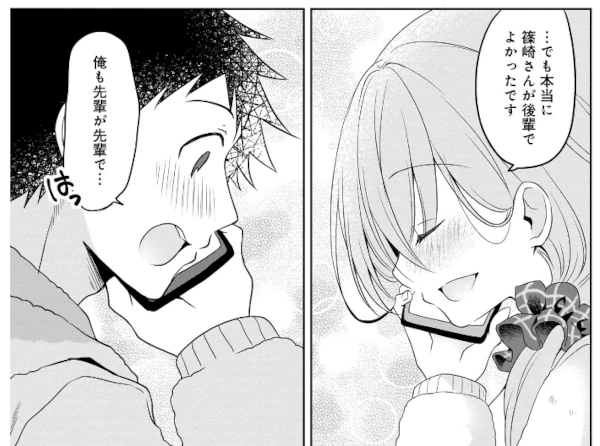This time, we’re introducing My Tiny Senpai —a manga where every “Good job, Shinozaki-kun” teaches you something about keigo, workplace relationships, and the soft power of Japanese politeness.
Work Information

My Tiny Senpai (うちの会社の小さい先輩の話)
Author: Saisou
Publisher: TAKESHOBO
Amount of text: moderate
Challenge level: ★★
Latest volume : Vol.11(Aug.2025 / Ongoing)
Story overview
The viral hit on Twitter (back then) with over 2.8 million likes—the “sweet-as-sugar office rom-com” everyone adored—is finally out as a manga!
Shinozaki, a new employee, works in the same department as his petite and irresistibly cute Senpai, Ms. Katase. She’s cheerful, always supportive, and incredibly good at giving compliments. Sometimes she even pats his head to cheer him up—and yes, even her “gentle power harassment” moments are oddly comforting.
A tiny, big-hearted Senpai with a little sister vibe and an angelic smile… isn’t that the ultimate fantasy?
The Appeal of This Manga
This story is dedicated to every working man trying his best despite daily stress. Sure, you might say, “There’s no way such a perfect office Madonna actually exists!” — but come on, don’t ruin the dream. Maybe, just maybe, a sweet, caring Senpai who lets you relax and be yourself might appear in your office one day too.
Don’t overthink it—just enjoy the warm, healing vibes.

Why this manga is suitable for learning Japanese
This manga is not only entertaining but also highly recommended for Japanese learners for several reasons.
Rich in Polite Language (Keigo)
Because the main characters are Senpai and Kōhai in a workplace setting, you’ll find plenty of examples of teineigo (polite speech). Interestingly, in modern Japanese offices, even Senpai often use polite language toward their juniors, and Katase-senpai does the same with Shinozaki. You’ll encounter many scenes featuring this rare combination: sweet, affectionate, and overly polite Senpai talk.

Realistic Depiction of Workplace Relationships
The manga carefully portrays various interactions—between Senpai and Kōhai, bosses and subordinates, and colleagues. You can sense the subtle nuances in tone and hierarchy that define communication in Japanese office culture.

Culture Spotlight
“Senpai” and “Kōhai”: Not Just a Manga Thing先輩
If you’ve watched even a few manga-based series or anime, you’ve definitely heard someone yell:
“Senpai〜! Wait for me!”
or maybe the classic embarrassed line:
“W-wait, Senpai!? It’s not what it looks like!”
Yep, senpai (先輩) has become one of those Japanese words that manga and anime fans all over the world instantly recognize. And thanks to the internet, it’s now even part of English slang—especially through the meme “Notice me, Senpai!”
But here’s the thing: in real-life Japan, senpai isn’t about blushing crushes or sparkly eyes (well, not usually). It’s actually a super important part of how Japanese people organize relationships, respect, and learning.

What “Senpai” and “Kōhai” Really Mean
In Japanese, senpai means someone who joined before you—whether it’s school, a club, or a company. They’ve got experience, wisdom, and maybe even the best seat in the office.
Kōhai (後輩), on the other hand, is the opposite: the newcomer, the junior, the one still figuring things out.
It’s not about age or power—it’s about order of arrival. Even a younger person can be your senpai if they joined earlier than you!
The senpai–kōhai system is like the backbone of Japanese teamwork. A senpai guides and supports, while a kōhai learns and shows respect. It’s less “boss and servant,” and more “mentor and apprentice”—like a built-in support network.
From the School Hallway to the Office Floor
The senpai–kōhai dynamic starts early. In school, you’ll see kōhai calling out “Senpai!” as they chase after older students for advice on clubs, exams, or life. Senpai might reply with a calm smile and a “Don’t worry, you’ll get the hang of it.”
Then, years later, it all repeats in the workplace. A new employee (the kōhai) learns how to send polite emails or handle clients from their senpai. There’s gratitude, respect, and a lot of quiet observation. No one says it out loud, but this system keeps things running smoothly—a key value in Japanese culture.
The “Senpai” of Manga, Anime, and the Internet
Now, in manga and anime, things get… spicier. Here, senpai often turns into the “cool, slightly distant senior” that everyone secretly admires. Cue the rom-com setup:
“Senpai, your lunchbox is open again…”
“Oh? Guess I forgot. Thanks, Kōhai.” (sparkle sparkle✨)
Before you know it, the kōhai’s heart is racing, cherry blossoms are flying, and we’ve got a love subplot.
This romanticized version of senpai—mysterious, kind, and totally oblivious—became so iconic that English-speaking fans picked it up too. Thus was born the internet’s cry of unrequited affection:
“Notice me, Senpai!”
Funny thing is, that’s not how the word is usually used in Japan. In real life, senpai is just a respectful title—something you’d say to your upperclassman or senior coworker, not your crush (unless you’re in a shōjo manga ).
Why This Matters for Language Learners
Understanding senpai and kōhai is like unlocking a secret level in learning Japanese. It’s not just vocabulary—it’s insight into how people connect, communicate, and show care.
These words carry the rhythm of Japanese relationships:
respect for experience, gratitude for guidance, and humility in learning. Even when you’re not saying “Senpai!”, the spirit of it is often there—in tone, politeness, and attitude.
So next time you hear “Senpai” in a manga or anime, smile at the trope—but also remember the deeper truth behind it. It’s not just a cute meme. It’s a reflection of how people in Japan learn from one another, with warmth, respect, and a dash of dramatic flair.
A Little Warning
Is it too “moe”?
Yes, Shinozaki often melts under his Senpai’s unintentional cuteness. You might think, “Come on, no one this pure and adorable could exist in real life!” If that’s your reaction—if you’re a bit too realistic—then maybe this manga isn’t for you.
But if you can just let go and enjoy the fluffy, heart-melting sweetness… your Japanese study time will feel a lot warmer with this angelic Senpai around.

Work Information

My Tiny Senpai (うちの会社の小さい先輩の話)
Author: Saisou
Publisher: TAKESHOBO
Amount of text: moderate
Challenge level: ★★
Latest volume : Vol.11(Aug.2025 / Ongoing)
Here’s a safe and convenient way to purchase Japanese manga.
This Blog’s ConceptIn this blog, we are introducing manga that are not only highly captivating but also ideal for Japanese language learners. Studying Japanese through manga is both fun and effective. Manga allows you to understand the subtleties of keigo (honorifics), teineigo (polite speech), and casual conversation in Japanese. We hope you find works that match your interests and use them to enhance your Japanese learning journey.